| |||||||||||
|
HODOYOSHI project
We participated in the FIRST program funded by the Cabinet Office "New paradigm of space development and utilization by nano-satellite" that was led by Prof. Shinichi Nakasuka in the University of Tokyo from the end of FY2009 to the end ofFY2013. Our research topic in this project was "Research and development of deployable structure". The overview of the project is shown in the web-page of Nano-Satellite Center.
This project was called "HODOYOSHI" project. During about four year's project, four nano-satellite with 50 - 70 kg weight were developed, and HODOYOSHI-1, 3, and 4 were launched in FY 2014. You can see the detail of each satellite in th following web pages:
Our laboratory conducted the following research and development with industries. Mr. Yuta Araki who was a researcher of our college played a central part in these R&D:
As for de-orbit device, we studied on membrane structure with convex tapes as extensible member as in the right figure. we analyzed its dynamics and derived the condition that the tape does not stacked in the storage.
HODOYOSHI project conducted the human resource development and capacity building of developing countries. As part of this activity, UNISEC held CLTP (CanSat Leader Training Program). UNISEC has been continuing CLTP after HODOYOSHI project. We co-hosted CLTP2 in Funabashi campus, and supports later CLTP. In HODOYOSHI project, our laboratory got many opportunities of collaboration with people in nano-satellite engineering field, and learned various things such as the project management, development method of nano-satllite, which is useful for our later research and development. Many people seem to expect that "HODOYOSHI reliability engineering" is the alternative to conventional design standard by space agencies, but from the experience of this project, we think "HODOYOSHI reliability engineering " is a kind of development method of products that is different from conventhional ones. Generaly speaking, industrial products are designed and developed with the requirement that "they do not break" and "they work as expected". Especially, non-repairable system such as rockets and satellites are required to satisfy this condition strictly, which appears in the requirement of high reliability. On the other hands, we design and develop nano-satellites under the condition that they sometimes do not work. This is because there seems to occur unknown phenomena in nano-satellites on orbit. For example, many nano-satellites have trouble on orbit during seveal weeks after the launch and the reason of each trouble is often unspecified. If we try to avoid the "probability of failure", we may have to use high performance components and parts and conduct various tests to keep high reliability. However, it is difficult to determine the components, parts, and tests to assure the performance of the satellite against unclarified phenomenon. We understand from our experience that the method to keep the reliability is different according to the given duration and budget for the development. If the time and the budget necessary for keeping the reliability is already prepared, there is no problem. Suppose that one method needs some duration and some budget, and another method needs another duration and budget. Then, which method do we choose? If we apply the above consideration to the example other than nano-satellite, we have the following questions: How low probability must we achieve for the failure of a product with unknown phenomenon and with low-probability critical phenomenon? How should we choose appropriate method to obtain the reliability with specific budget and time? In the former case, we will not choose the above method for high reliability, but we will choose the following method: "to rest the system". "to have redandancy for electric circuit", "to prepare various uplink command", "to have re-programming function", "to make other component work instead of the failed component", "to change the component or parts into more simple ones" even if they are heavier or larger than the original ones and to cancel the increase of the weight and volume by reducing the weight and vomule of other components. In the later case, we will choose the same method if the time and budget is less. In other word, the method to assure the reliability is varied according to the time and budget. We think the criteria will be the workload of each method. In conclusion, there are lots of cases where the "reliability" that means the increase of the success probability can be improved with low cost by the following idear and concept: "it is not necessary to distribute the requirement into each component or subsystem if the whole system satisfies the requirement", "in that case, the redundancy is ensured not by two or more same subsystems are mounted in parallel, but by realizing a function through two or more routes in a system", the system is designed on the assumtion that the system often does not work". We think this is true in case that there is any unkown phenomenon, or some phenomenon that may occur even though the probability is low, or the budget and time is extremely limited. [reference] 高野忠, 宮崎康行, 展開型フェーズドアレイアンテナ, 特許第5672606号, 2015年1月9日. 荒木友太, 吉野達也, 宮崎康行, 小型人工衛星用パネル展開機構の軌道上成果, 第58回宇宙科学技術連合講演会,JSASS-2014-4515, pp.1-5, 2014年11月12日〜14日,長崎ブリックホール,長崎, 2014. 村田亮, 井上翔太, 宮崎康行, 「宇宙構造物の伸展部材用コンベックステープの展開挙動」, 第56回構造強度に関する講演会講演集, 1A17(JSASS-2014-3018), pp.45-47, 平成26年8月6日〜8月9日, 浜北文化センター, 2014. Tetsuya Isomura, Tatsuya Yoshino, Masaki Kano, and Yasuyuki Miyazaki, "Analysis Method of Deployment Mechanism of Panel Structure for Micro Satellite", Digital Proceedings of 29th International Symposium on Space Technology and Science (ISTS2013), 2013-c-25, pp.1-6, Jun 2-9, 2013, Nagoya Congress Center, Nagoya, Japan. 荒木友太, 宮崎康行, 山口耕司, 「超小型衛星用パネル展開デバイスの開発」, 第56 回宇宙科学技術連合講演会講演集, 2M09, JSASS-2012-4475, pp.1-4, 平成24年11月20日−22日, 別府国際コンベンションセンター, 2012. Tatsuya Yoshino, Yuta Araki, Yasuyuki Miyazaki, "Development of a hold release mechanism of a panel structure for Nano-Satellite", International Conference on Space, Aeronautical and Navigational Electronics 2012, pp.1-5, October 10-12, The SONGDO CONVENSIA, Incheon, Korea, 2012. Yasuyuki Miyazaki, Yuta Araki, Tetsuya Isomura, Masaki Kano, "A Simple Deployment Mechanism of Panel Structure for Micro Satellite and Its Verification", 63rd International Astronautical Congress, IAC-12-C2.2.7, pp.1-9, Mostra d'Oltremare, Naples, Italy, October 1-5, 2012. | |||||||||||
|

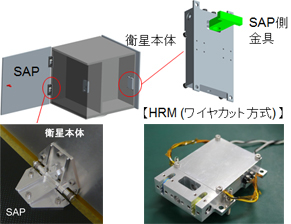
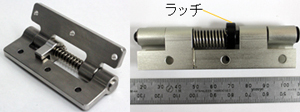
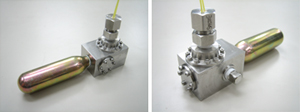
 The right figure shows a cenceptual model of high stiffness and high precision deployable panel that has a back structure consisting of self-deployable truss. Its joints are made of SCSMA (single crystal shape memory alloy).
The right figure shows a cenceptual model of high stiffness and high precision deployable panel that has a back structure consisting of self-deployable truss. Its joints are made of SCSMA (single crystal shape memory alloy).
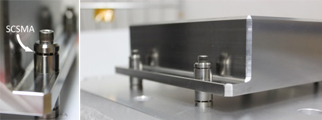 The right photo shows the vibratin surpression device to isolate the vibration of satelite equipments. The device was used instead of bolts. This is made by WEL Research. We continue the collaboration with WEL Research.
The right photo shows the vibratin surpression device to isolate the vibration of satelite equipments. The device was used instead of bolts. This is made by WEL Research. We continue the collaboration with WEL Research.

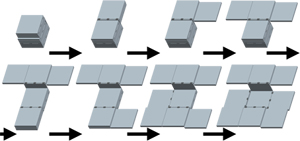 We studied on a muti-folding panel assumed to be used for a phased array antenna on a nano-satellite, and obtained a patent.
We studied on a muti-folding panel assumed to be used for a phased array antenna on a nano-satellite, and obtained a patent.